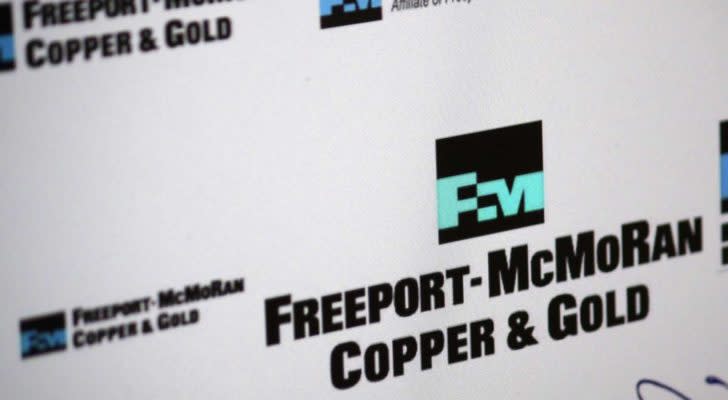7 Real Asset Stocks to Buy to Protect Against Inflation
Real asset stocks have inflation-hedging characteristics. As such, these inflation stocks are gaining traction among investors. After all, the supply-demand dynamics during the pandemic have led to increased pressure on many items, especially food and energy resources.
The most recent numbers from the U.S. Bureau of Labor Statistics show that the consumer price index (CPI) soared 7.5% compared to a year ago. That exceeds Wall Street estimates. As such, investors are taking inflation more seriously and shifting a portion of their portfolio exposures into real asset stocks. Further, recent research highlights the following:
“Inflation […] might create substantial distortions in financial statements, future earnings, and overall performance of securities in the financial market. An inflation-hedging ability of an asset offers protection against inflation, which eliminates or at least reduces the uncertainty about the future real returns.”
InvestorPlace - Stock Market News, Stock Advice & Trading Tips
Since they have intrinsic value, prices of real assets tend to increase as inflation goes up. Therefore, it’s not surprising that investors are increasingly focused on real estate, infrastructure, commodities, natural resources and precious metals.
In times of high inflation, JPMorgan Chase suggests that real estate investors benefit from a natural hedge. In addition, companies in cyclical industries with significant pricing power see strong revenue growth. These include names like industrials and commodities stocks. Diversifying into such inflation stocks offers a convenient way to protect long-term portfolios during heightened volatility.
So, with all that information said, here are seven real asset stocks that could provide a safe haven against surging inflation:
Cheniere Energy (NYSEAMERICAN:LNG)
Enbridge (NYSE:ENB)
Freeport-McMoRan (NYSE:FCX)
Invesco Real Assets ESG ETF (BATS:IVRA)
Prologis (NYSE:PLD)
SBA Communications (NASDAQ:SBAC)
SPDR S&P Metals & Mining ETF (NYSEARCA:XME)
Inflation Stocks to Buy: Cheniere Energy (LNG)

Source: IgorGolovniov / Shutterstock.com
52-week range: $65.23 – $121.31
Dividend yield: 1.15%
First up on this list of inflation stocks, energy infrastructure group Cheniere Energy provides liquefied natural gas (LNG) to integrated energy companies, utilities and energy-trading firms worldwide. The company enjoys stable cash flow due to its long-term contract backlog of LNG sales as well as purchase agreements.
Cheniere Energy issued third-quarter 2021 results in early November. For the period, revenue increased 119% year-over-year (YOY) to $3.2 billion. However, the net loss also widened to $1.08 billion, or $4.27 loss per diluted share, compared to a net loss of $463 million a year ago. This loss was primarily due to an increase in derivative trading losses indexed to international LNG prices. Finally, cash and equivalents ended the period at $2.2 billion.
This exporter is planning a 10 million-ton-per-year expansion at its Texas export facility. In addition, its recent expansion project — the liquefaction Train 6 at its Louisiana facility — started operations in early February.
Management is anticipating $1 billion in debt reduction annually until it it improves its credit rating. The board has also approved $1 billion in share repurchases until 2025.
LNG stock currently hovers at $115 territory, up 68% over the past 12 months. Shares are trading at a forward price-earnings (P/E) ratio of 17.4 times and a trailing price-sales (P/S) ratio of 2.1 times. The 12-month median price forecast for LNG stock is $131.50. Given the recent run-up in price, interested readers could wait for a pullback toward $110 or even lower.
Enbridge (ENB)
52-week range: $33.78 – $43.72
Dividend yield: 6.4%

Source: bht2000 / Shutterstock.com
Next up on this list of inflation stocks, Canada-based Enbridge is another energy infrastructure name. The company has oil and natural gas pipelines, a natural gas utility operation and renewable energy assets. Enbridge has a fee-based business model that generates reliable cash flow. The company also transports more than a quarter of total crude oil production in North America.
Management issued Q4 and full-year 2021 results on Feb. 11. For the period, adjusted earnings came in at $1.38 billion, or 68 cents per share. On the metrics, president and CEO Al Monaco remarked the following:
“We placed $10 billion of growth capital into service, including the Line 3 Replacement Project, which will generate significant cash flow growth in 2022 and provide a foundation for future growth.”
In 2022, the company’s Line 3 Replacement Project is forecast to drive growth. Moreover, Enbridge announced its acquisition of Moda Midstream for $3 billion last year, which includes the Ingleside Energy Center and related pipeline and logistics assets. The company is even using its ample cash flow to transition its business toward cleaner energy; it currently plans to install 60 megawatts of solar power at the Ingleside facility.
Currently, ENB stock is changing hands around the $41 mark, up 19% over the past year. Shares are trading at 17 times forward earnings and 2.3 times trailing sales. The 12-month median price forecast for Enbridge stands at $44.93. What’s more, Enbridge is a Dividend Aristocrat with a lucrative 6%-plus dividend yield.
Inflation Stocks to Buy: Freeport-McMoRan (FCX)
52-week range: $29.45 – $46.20
Dividend yield: 0.68%

Source: 360b / Shutterstock.com
Freeport-McMoRan — one of the world’s largest copper producers — is the next pick of the inflation stocks on this list. In terms of recoverable reserves, this company’s Indonesian Grasberg mining complex is one of the largest copper and gold mines globally.
Freeport announced Q4 2021 results on Jan. 26. For the fourth quarter, revenue increased 37% YOY to $6.2 billion. Net income came in at $1.11 billion as well, or 74 cents per diluted share. That’s compared to $708 million in the prior-year quarter, or 48 cents per diluted share. Lastly, cash and equivalents ended the period at $8.1 billion.
Copper is currently trading around $4.50 per pound. The average realized price per pound of copper was $4.33 in 2021, up 47% YOY from $2.95 in 2020. Analysts note that there are increasing signs of tight supply constraints in the copper market. Inventories have fallen to historically low levels, pushing the price of copper up to its highest level since October.
Freeport has a favorable production profile for the coming years. Copper is a key commodity for electric vehicles (EVs), solar panels, smart buildings and connectivity. Therefore, the Street expects Freeport-McMoRan to enjoy long-term growth.
Currently, FCX stock changes hands around $44, up 33% over the past year. Shares are trading at 12.1 times forward earnings and 2.9 times trailing sales. The 12-month median price forecast for FCX stock stands at $48.
Invesco Real Assets ESG ETF (IVRA)
52-week range: $12.34 – $15.78
Dividend yield: 2.02%
Expense ratio: 0.59% per year

Source: shutterstock.com/eamesBot
Our next choice on this list of inflation stocks is actually an exchange-traded fund (ETF), the Invesco Real Assets ESG ETF. This fund invests in North American real asset stocks. Fund managers also pay close attention to environmental, social and governance (ESG) standards when making investment decisions.
IVRA is a relatively new and small fund. It was first listed in December 2020. Net assets stand at $2.8 million. Therefore, it does not offer much trading history. Investors should also note that the fund is an actively managed, non-transparent ETF. Unlike most ETFs, such non-transparent funds do not have to disclose their daily holdings.
The U.S. Securities and Exchange Commission (SEC) first allowed non-transparent ETFS in late 2019. By not revealing their portfolios daily, fund managers hope to prevent others from copying their investment strategy.
IVRA has 55 holdings. Real estate names account for the largest portion in the tracking basket with 53.16%, followed by energy (20.71%) and materials (13.32%). The leading names on the roster include e-commerce real estate investment trust (REIT) Prologis, cell tower REIT American Tower (NYSE:AMT), apartment community REIT UDR (NYSE:UDR) and utility company PPL (NYSE:PPL).
Over the past 12 months, IVRA has gained about 17%. However, since the start of the year, IVRA is down 3.5%. Although it is a new fund, it certainly deserves your attention.
Inflation Stocks to Buy: Prologis (PLD)
52-week range: $94.14 – $169.93
Dividend yield: 1.72%

Source: rafapress / Shutterstock.com
Prologis has become one of the largest industrial REITs worldwide by dominating the e-commerce warehouse space. This California-based REIT owns roughly a billion square feet of space in industrial and logistics facilities spread across about 20 countries.
Like other inflation stocks on this list, Prologis announced Q4 2021 results back in January. For the period, revenue went up by 15% YOY to $1.28 billion. Net earnings also skyrocketed to $1.25 billion during the quarter, up from $280.4 million in the prior-year period. Core funds from operations per diluted share came in at $1.12, compared to 95 cents in the prior-year period. Finally, cash and equivalents ended the quarter at $556 million.
In 2021, Prologis raised rental rates on renewal leases by 33%. Management is forecasting rental growth of roughly 10% in 2022. These increases are expected to boost long-term growth as more and more leases come up for renewal. CEO Hamid Moghadam noted the following:
“Demand for our 1 billion square foot global portfolio shows no signs of slowing and we are positioned ideally to meet our customers’ most critical real estate needs.”
Prologis estimates that the U.S. needs 800 million square feet of new warehouse space in the coming years. Catalysts include growing e-commerce operations as well as supply-chain disruptions.
Currently, PLD stock hovers around $143, up roughly 35% over the past 12 months. However, shares do not look cheap at 5o times forward earnings and 20.7 times trailing sales. The 12-month median price forecast for PLD stock is $174. Interested investors may want to wait for a pullback toward $140 or lower.
SBA Communications (SBAC)

Source: SERDTHONGCHAI / Shutterstock.com
52-week range: $232.88 – $391.15
Dividend yield: 0.76%
Based in Florida, SBA Communications operates wireless communications infrastructure. The company rents out antenna space on its multi-tenant communications sites under long-term contracts. Its customers are wireless service providers. This business model provides SBA with a recession-resilient revenue stream.
This pick of the inflation stocks announced Q3 2021 results in early November. For the quarter, revenue increased 13% YOY to $589.3 million. Net income came in at $47.8 million, or 43 cents per diluted share. That was up from $22.6 million, or 20 cents per diluted share, in the prior-year quarter. What’s more, adjusted funds from operations (AFFO) stood at $302.5 million, up 12% YOY. Cash and equivalents ended the quarter at $252.3 million.
In the United States, 5G deployment has introduced another term into wireless vocabulary: the C-band. This refers to “radio frequency bands between 4 and 8GHz” and its use brings “faster speeds and better coverage.”
The recent C-band auction was one of the highest-grossing spectrum auctions held in the States, with gross proceeds hitting $81 billion. SBA management predicts that the increased use of the C-band spectrum will be a key growth driver long-term. Meanwhile, the company is currently negotiating with Dish Network (NASDAQ:DISH) in setting up its nationwide 5G network.
SBAC stock hit an all-time high of $391.15 at the end of 2021. Now, though, it’s trading around the $300 mark, down 23% year-to-date (YTD). Despite the recent decline, SBAC still has a rich valuation at 93 times forward earnings and 14.8 times trailing sales. Meanwhile, the 12-month median price forecast for the stock stands at $382. Potential investors should wait for a pullback toward $275 or below before investing.
Inflation Stocks to Buy: SPDR S&P Metals & Mining ETF (XME)
52-week range: $34.91 – $50.78
Dividend yield: 0.64%
Expense ratio: 0.35% per year

Source: shutterstock.com/Imagentle
Our final choice on this list of inflation stocks is another ETF, the SPDR S&P Metals and Mining ETF. This fund provides access to the metals and mining segment of the S&P 500. These businesses are mostly focused on sub-industries like aluminum, copper, steel, precious metals, consumable fuels and mining.
XME has 32 holdings and was launched in June 2006. The fund has net assets of $2.4 billion. Furthermore, in terms of sectors, steel dominates the ETF with 39.4%, followed by coal and consumable fuels (17.9%), aluminum (14.9%) and gold (12.3%). The leading stocks on the roster include Peabody Energy (NYSE:BTU), Alcoa (NYSE:AA), Arch Resources (NYSE:ARCH), Allegheny Technologies (NYSE:ATI), Newmont (NYSE:NEM) and Freeport-McMoRan, among others.
This fund has returned 39% in the past year. What’s more, XME recently hit a multi-year high of $50.78. It currently hovers around this peak value. The ETF is up 12.3% YTD. A potential decline toward $47 would improve the margin of safety here.
On the date of publication, Tezcan Gecgil did not hold (either directly or indirectly) any positions in the securities mentioned in this article. The opinions expressed in this article are those of the writer, subject to the InvestorPlace.com Publishing Guidelines.
Tezcan Gecgil has worked in investment management for over two decades in the U.S. and U.K. In addition to formal higher education in the field, she has also completed all 3 levels of the Chartered Market Technician (CMT) examination. Her passion is for options trading based on technical analysis of fundamentally strong companies. She especially enjoys setting up weekly covered calls for income generation.
More From InvestorPlace
The post 7 Real Asset Stocks to Buy to Protect Against Inflation appeared first on InvestorPlace.
